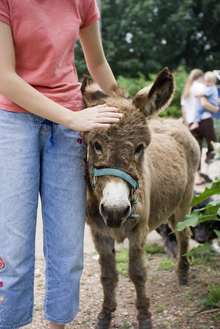A three legged miniature donkey named Emma has been making headlines because of her attitude and playfulness in spite of having had several surgeries after being born with a rear hoof that wouldn't extend, leaving her crippled and unable to walk.

Typical miniature donkey with friend
A three-legged miniature donkey named Emma has been making headlines because of her attitude and playfulness in spite of having had several surgeries and a prosthetic leg.
Emma has become a test case for veterinarians hoping to save the lives of horses, donkeys and similar animals that are typically euthanized because of leg deformities or fractures.
After Emma underwent surgery to amputate the limb at Auburn University when she was just a foal she was fitted with a prosthetic limb.
Now, she engages in typical donkey antics, kicking playfully with her prosthetic leg and acting like any other miniature donkey including taking her rightful place with other animals and the people who care for her.
Over the years, Emma has outgrown several prosthetic legs as she has grown. The limbs are a combination of heavy-duty, molded plastic impregnated with carbon fiber for strength.
To put the prosthetic on the donkey, handlers must fit Emma’s stump with a sock and a rubbery sleeve before putting her leg back into the device. Then she can go for a walk.
Veterinary experts and students have learned important lessons from Emma, like how to place the sleeve in a way that her stump isn’t irritated by sand when she lays down in the corral and rolls around while wearing the prosthetic.
Dr. Fred Caldwell, who has been involved with Emma’s treatment from the start, said the team caring for the 175-pound donkey hopes to transfer the lessons learned to larger animals such as horses, which are much more difficult to equip with prosthetics because of their weight and size.
He said a handful of attempts have been made in larger animals, some more successful than others.
“I think every case that we achieve success in we get a little closer for this being something that we can offer as a potential routine therapy down the road,” said Caldwell, an associate professor at Auburn.
